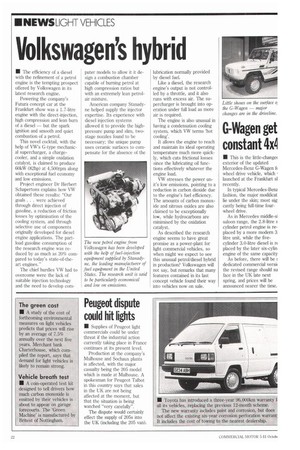Volkswagen's hybrid
Page 24

If you've noticed an error in this article please click here to report it so we can fix it.
• The efficiency of a diesel with the refinement of a petrol engine is the tempting prospect offered by Volkswagen in its latest research engine, Powering the company's Futura concept car at the Frankfurt show was a 1.7-litre engine with the direct-injection, high compression and lean burn of a diesel — but the spark ignition and smooth and quiet combustion of a petrol.
This novel cocktail, with the help of VW's G-type mechanical supercharger, a chargecooler, and a simple oxidation catalyst, is claimed to produce 60kW (82hp) at 4,500rpm along with exceptional fuel economy and low emissions.
Project engineer Dr Herbert Schapertons explains how VW obtained these results: "Our goals. . were achieved through direct injection of gasoline, a reduction of friction losses by optimisation of the cooling system, and through selective use of components originally developed for diesel engine applications. The partload gasoline consumption of the research engine was reduced by as much as 20% compared to today's state-of-theart engines."
The chief hurdles VW had to overcome were the lack of suitable injection technology and the need to develop corn puter models to allow it it design a combustion chamber capable of burning petrol at high compression ratios but with an extremely lean petrolair mixture.
American company Stanadyne helped supply the injector expertise. Its experience with diesel injection systems allowed it to provide the highpressure pump and slim, twostage nozzles found to be necessary; the unique pump uses ceramic surfaces to compensate for the absence of the The new petrol engine from Volkswagen has been developed with the help of fuel-injection equipment supplied by Stanadyne, the leading manufacturer of fuel equipment in the United Stales. The research unit is said to be particularly economical and low on emissions. lubrication normally provided by diesel fuel.
Like a diesel, the research engine's output is not controlled by a throttle, and it also runs with excess air. The supercharger is brought into operation under full load as more air is required.
The engine is also unusual in having a condensation cooling system, which VW terms 'hot It allows the engine to reach and maintain its ideal operating temperature much more quickly, which cuts frictional losses since the lubricating oil functions effectively whatever the engine load.
VW stresses the power unit's low emissions, pointing to a reduction in carbon dioxide due to the engine's fuel efficiency. The amounts of carbon monoxide and nitrous oxides are also claimed to be exceptionally low, while hydrocarbons are minimised by the oxidation catalyst.
As described the research engine seems to have great promise as a power-plant for light commercial vehicles, so when might we expect to see this unusual petroUdiesel hybrid in production? Volkswagen will not say, but remarks that many features contained in its last concept vehicle found their way into vehicles now on sale.










































































































































































